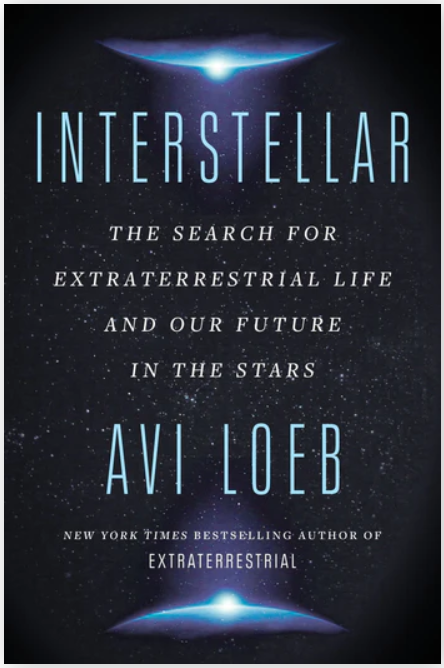
Harvard astronomer Avi Loeb has a new book coming out today (August 29, 2023). It’s being released just five days after the New York Times called Loeb “the most famous practicing astronomer in the country.” Loeb isn’t a household name, exactly, but his name comes up often in science circles and on social media, and we publish stories about him here at EarthSky. Let’s face it. Loeb thinks about, and talks about, some pretty extraordinary subjects. It’s fair to say he thinks outside the box.
The new book is called Interstellar: The Search for Extraterrestrial Life and Our Future in the Stars. It follows on the heels of a 2021 book called Extraterrestrial: The First Sign of Intelligent Life Beyond Earth.
The earlier book was about ‘Oumuamua, which swept through our solar system in 2017. This object was the first known visitor from another solar system. Some thought it was a comet, but Loeb disagreed. He thought ‘Oumuamua might be an artifact, made by intelligent beings from another world.
The first part of the new book discusses the Galileo Project, which Loeb founded in 2021. It’s a scientific group whose stated goal is:
… to bring the search for extraterrestrial technological signatures of Extraterrestrial Technological Civilizations … from accidental or anecdotal observations and legends to the mainstream of transparent, validated and systematic scientific research.
See what we mean? Loeb thinks about, and talks about, some very interesting things.
He has his critics
We see disparaging remarks about Loeb sometimes on Twitter. It’s reminiscent of the way professional astronomers used to talk about Carl Sagan. They didn’t take kindly to the publicity surrounding Sagan. Likewise, Loeb gets a lot of publicity. The recent New York Times article picked up on some of the disparaging talk when it wrote:
Yet many in his own field consider Loeb a pariah [outcast]. His more polite critics say that he is distracting from the horizon-expanding discoveries astronomers are making with new instruments like the James Webb Space Telescope. The more outspoken ones accuse Loeb of abandoning the scientific method and misleading the public in pursuit of fame.
What are UAP?
And now Unidentified Aerial Phenomena or UAP (formerly UFOs) have become all the rage. One reason is that military pilots have come forward in recent years, with reports of unknown objects seen in the skies or on radar. And there’ve been sessions in Congress to try to get to the bottom of these reports.
Meanwhile, the Galileo Project has installed cameras pointing at the sky atop the Harvard College Observatory. They’re looking for their own evidence of UAP from downtown Cambridge, Massachusetts, which is across the river from Boston and about as urban as it gets. It sounds far-fetched. But Loeb explains his rationale this way:
… UAP are not science fiction. They are simply science. Explaining the physical world’s phenomena is what the scientific method was invented for. The universe, of course, is full of unexplained and insufficiently explained phenomena. Some remain squarely in the realm of theory – dark matter, for just one example. Others, like UAP, are questions answerable through the collection of more and better observational data.
What is more, we know manufactured technology arriving from interstellar space is plausible because we’ve already sent human-manufactured technology into interstellar space. The effort to answer whether another civilization has done likewise, and perhaps with far greater sophistication, quickly presents us with some of the most awesome, enduring questions of human civilization.
Loeb goes on to say:
Scientists must do what the nations’ militaries are poorly designed to do. We must commence a planet-wide search for curiosities. When it comes to UAP, we must build with transparency and disperse observatories uniquely conceived to gather data that permit humanity to routinely identify UAP such that they are ever more accurately winnowed down into bins of the explainable.
Interstellar remnants in the ocean
The Galileo Project has a goal to search and recover anomalous interstellar meteors. They have already worked toward this goal this summer, but, as it turns out, without the proper permits. Papua New Guinea was displeased with their guests, who came by sea and took away tiny spherules they claim might be from an alien spacecraft or possibly an interstellar meteor.

A broader search for aliens
Loeb envisions our search to be not just for aliens and their messages of welcome, but for an advanced technology’s garbage. As he says in the book:
Humans produce far more waste products than they do deliberately built, well-calibrated scientific instruments. Like plastic bottles in our planet’s oceans, it’s easier to imagine [that] technological debris more akin to extraterrestrial trash from distant civilizations may have been accumulating in interstellar space for billions of years.
Some of it could well have landed on the planets of the solar system, and those planets with little to no atmosphere may well hold the most intact deposits. Again, we will not know until we go and look.
ET may be AI
And while Loeb isn’t disinclined to believe in UAP, he seems less likely to believe they’re piloted by alien beings. Life in any form would have a hard time conquering the huge distances of space. Instead, he said that ET are more likely to be artificial intelligence (AI).
The kind of sentient being capable of roaming the universe may not be biological at all. Despite the naïve storylines of interstellar travel in science fiction, Darwinian evolution has not selected for the kinds of traits that would allow biological creatures to survive travel between stars. This is almost certain to be true of any creature optimized to persist within the confines of a home planet. The interstellar trip must span many generations since even the speed of light requires tens of thousands of years to travel between stars throughout the Milky Way disk and ten times longer to cross its halo.
In fact, Loeb says that our emerging AI may be more appealing to aliens than we are. Loeb continues:
It is far more probable that a sentient AI spacecraft would undertake that journey. In which case, an AI system that we produce might have a more intimate connection to an extraterrestrial AI system than to us. If some UAP represent extraterrestrial AI systems, perhaps their appearance would be explained by humanity’s nearness to developing its own sentient AI.
Waxing philosophical
Loeb spends much of the book waxing philosophical and even spiritual. He talks about how Earth is a D-class civilization, while he hopes to make contact with aliens that are higher classes. Here’s how he describes Earth’s collective humanity:
We are currently a D-class civilization, characterized by our short-sighted pursuit of selfish goals at the expense of the long-term survival of our civilization and our planet … To jolt us out of our current complacency, humanity needs a sufficiently grand ambition. That ambition, I am convinced, is the scientific and technological pursuit of proof of an extraterrestrial technological civilization.
Avi Loeb and controversy
Loeb isn’t unaware of the controversy that surrounds him and his work. In the book, Loeb answers his critics:
My critics have declared that Professor Loeb sees artificially created extraterrestrial debris wherever he looks. Nothing could be further from the truth. What I do is allow for a hypothesis that matches available data, and thereafter I seek better data to test, confirm, or reject my or other competing hypotheses. That I do so with human worries and wishes only means I am human.
One clear message in the book is that Loeb is impatient to find alien intelligence.
If we’re the only civilization on the cosmic ladder of civilizations, the rung to which we cling remains the same, though our prospects become less hopeful. Our predicament is, if human civilization doesn’t learn to replicate the circumstances that can sustain it elsewhere, indeed everywhere, throughout the universe, it will end. Accomplishing that entirely on our own seems less likely than accomplishing it with assistance from a more advanced sentient intelligence’s technology. If we’re alone, our odds of success go down, but otherwise nothing has changed.
Alone or not, our civilization must set itself the task of ensuring that terrestrial life, and human civilization, endure if they are to endure at all.
Bottom line: Avi Loeb’s new book “Interstellar” delves into UAP, retrieving artifacts from other civilizations, and examining the idea that we are more likely to encounter ET’s trash or AI than ET itself.
Read more: Sea-going search for alien fragments yields odd spherules
The post Interstellar, a new book by Avi Loeb first appeared on EarthSky.
0 Commentaires